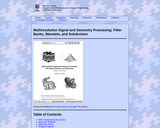TEXTBOOK ABSTRACT:
This book is intended for use in the teaching of graduate and senior undergraduate courses on multiresolution signal and geometry processing in the engineering and related disciplines. It has been used for several years for teaching purposes in the Department of Electrical and Computer Engineering at the University of Victoria and has been well received by students.
This book provides a comprehensive introduction to multiresolution signal and geometry processing, with a focus on both theory and applications. The book has two main components, corresponding to multiresolution processing in the contexts of: 1) signal processing and 2) geometry processing.
The signal-processing component of the book studies one-dimensional and multi-dimensional multirate systems, considering multirate structures such as sampling-rate converters, filter banks, and transmultiplexers. A particularly strong emphasis is placed on filter banks. Univariate and multivariate wavelet systems are examined, with the biorthogonal and orthonormal cases both being considered. The relationship between filter banks and wavelet systems is established. Several applications of filter banks and wavelets in signal processing are covered, including signal coding, image compression, and noise reduction. For readers interested in image compression, a detailed overview of the JPEG-2000 standard is also provided. Some other applications of multirate systems are considered, such as transmultiplexers for communication systems (e.g., multicarrier modulation).
The geometry-processing component of the book studies subdivision surfaces and subdivision wavelets. Some mathematical background relating to geometry processing is provided, including topics such as homogeneous coordinate transformations, manifolds, surface representations, and polygon meshes. Several subdivision schemes are examined in detail, including the Loop, Kobbelt sqrt(3), and Catmull-Clark methods. The application of subdivision surfaces in computer graphics is considered.
A detailed introduction to functional analysis is provided, for those who would like a deeper understanding of the mathematics underlying wavelets and filter banks. For those who are interested in software applications of the material covered in the book, appendices are included that introduce the CGAL and OpenGL libraries. Also, an appendix on the SPL library (which was developed for use with this book) is included. Throughout the book, many worked-through examples are provided. Problem sets are also provided for each major topic covered.



